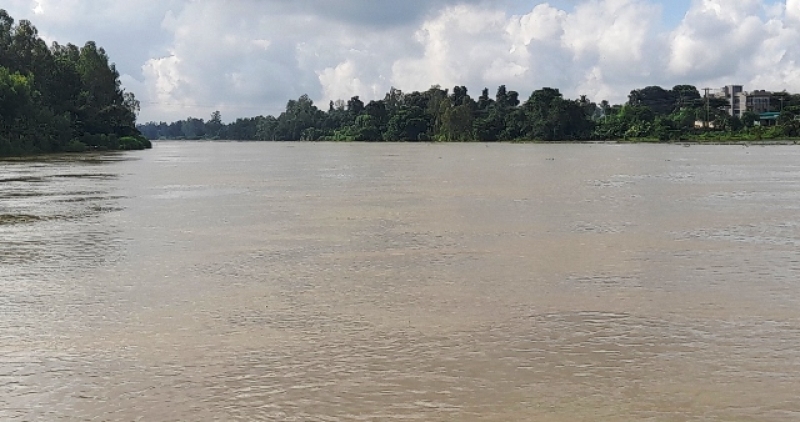- Dhaka's air quality in 'moderate' range on Saturday morning |
- Deadly Floods Displace Over 100,000 in South Sudan |
- Nepal has first woman Prime Minister as March elections set |
- 50 Killed as Israel Intensifies Strikes on Gaza City |
- UN General Assembly Endorses New York Declaration on Two-State Solution |
Flood emergency in Bangladesh for reckless river handling
Basinwide water management must for win win solution saving rivers

Atrai River flows above the danger level in Naogaon. UNb
Dhaka, August 17, 2025 — Bangladesh is grappling with one of its most widespread flood emergencies in recent years, as nearly all major rivers in the Brahmaputra and Ganges basins surge past danger levels, inundating vast swathes of the northern and northwestern districts. The Teesta, Ganges, and Brahmaputra rivers—typically reduced to trickles during the lean season due to upstream diversions—have now unleashed waves of destruction following heavy monsoon rains and upstream releases from neighboring countries.
The Teesta River, long a symbol of dry-season deprivation due to water diversion from the Gajaldoba Barrage in West Bengal, India, has now turned into a torrent. All 44 gates of the Teesta Barrage have been opened, sending floodwaters downstream. The river has flowed above the danger mark at Dalia, Nilphamari, submerging large areas in Lalmonirhat, Kurigram, and Rangpur.
The Ganges, which rolls down limited quantum of water in the dry season, has now flooded the entire Ganges-dependent region of the country. Water levels have surged across districts including Rajbari, Faridpur, Pabna, and Manikganj. The Padma, a distributary of the Ganges, is rising steadily and may reach warning levels in the coming days.
The Brahmaputra-Jamuna system is swelling rapidly, threatening low-lying areas across the north, with forecasts predicting continued rise for at least three more days. The Atrai River is flowing above danger level in Naogaon, posing flood risks to surrounding communities. In the southeast, the Feni River has already caused flooding, adding to the nationwide crisis. Almost all rivers in the lower Brahmaputra and lower Meghna basins are rising steadily.
Over 100,000 people have been stranded across the northern districts, with homes, croplands, and infrastructure submerged. In Nilphamari alone, 10,000 families are marooned, while in Chapainawabganj, floodwaters have devastated over 2,000 hectares of crops. Relief efforts are underway, but local officials report shortages of food, drinking water, and shelter.
The crisis has reignited calls for a basinwide management approach to Himalayan rivers. Bangladesh, as the lower riparian country, bears the brunt of seasonal extremes—parched rivers in the dry months due to upstream diversions, and catastrophic floods during the monsoon. Experts and policymakers urge Dhaka to initiate dialogue with India, Nepal, Bhutan, and China for a transboundary water-sharing framework that ensures equitable distribution during lean seasons, coordinated flood control and early warning systems, and ecological preservation of river systems from source to sea.
Environmental advocates stress that the Teesta’s dry season diversion at the Gajaldoba Barrage and the Ganges’ reduced flow due to upstream dams are emblematic of a broader imbalance. “Bangladesh cannot continue to take the unequal load of dried rivers in the lean season and flood disasters in the wet season,” said one official, calling for a “win-win solution” that keeps rivers alive and communities safe.

